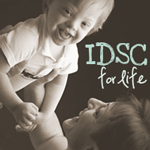This was posted on another email list and I found it interesting. Perspective is so much! If we would've listened to the "possibilities" of Down syndrome when we were given the diagnosis after Osiyyah was born, he wouldn't be who he is today. Praise God, he's given us the wisdom, skills, knowledge & ability to let Osiyyah thrive far beyond the dark, sad "possibilites" those so called "professionals" told us that day.
My first daughter was diagnosed with Down syndrome soon after she was born. Her language is delayed. Her abstract thinking abilities impaired. She is easily distracted and sometimes refuses to follow or listen to directions. She has some autistic-like tendencies. She has a bilateral hearing loss. Hearing aides have been recommended but she refuses to wear them. She has an uncorrected vision of 20/200 and a corrected vision of 20/60 at a distance. She is highly farsighted with nystagmus. She can be extremely stubborn and sometimes makes inappropriate comments. She can perform some functional tasks but has trouble with basic tasks like counting money and making change. She can follow simple cooking instructions. She can make her bed.
My second daughter is a sophomore in college. She is majoring in science. She loves anatomy and physiology, biology and anything connected to science. She loves to read but because of a vision loss she needs to take frequent breaks. She has a hearing loss so it helps if she can see the speaker and keep background noise to a minimum. Recently, she has become very interested in sketching portraits. Because of this new interest she is taking a course in advanced drawing. She is popular – the life of the party. She loves to flirt – in fact, her senior class in high school voted her most flirtatious. She has many friends. She has the ability to make other people feel welcome and loved. She is persistent, loves having fun and has a great personality. She loves to dance, travel and write to and receive letters from friends. She dreams of starting her own rock band.
The story of my two daughters illustrates the power of our words and our perspectives. It illustrates the power of the scientific processes and the labels we continue to use to diagnose, predict and sort people.
How? Both stories are about the same person, my daughter. The stories “differ in the way they are constructed – in their purpose – in their consequences – and in the assumptions they shape.” (O’Brien & Mount)
The story about my "first daughter” was constructed from exact words and phrases found on my daughter's school and employment related documents, written in the language of professionals, educators, psychologists and job specialists. It tells what she can’t do, won’t do and why. In this story, she is in need of repair, and thus in need of lots of professionals to fix her. The purpose of this story, in part, is compliance with federal and state regulations. The first consequence is that we (and the rest of society) accept the story as true and begin to adopt the language and beliefs and practices. Once that happens, the sad consequence is segregation, a client’s life, a planned life surrounded by professionals. The assumption in the story about my first daughter is that she is needy, broken, difficult and – most important – that her life should be safe and predictable surrounded by the service system.
The story about my “second” daughter was constructed from love, experience and by paying attention to gifts. It is told from the perspective that my daughter has immeasurable capacity once she has a valued and connected life in her community. The story about my second daughter is shaped (and lived) from a capacity perspective. This story is told in “context” of a life connected to others, a life that unfolds in exciting and unexpected ways precisely because of the many relationships she has. The consequences of this story are community and risk taking and surprises. The consequence is citizenship. The assumption in the story about my second daughter is that she is person who has capacity, interests, gifts, and contributions especially when her life unfolds in the presence of and participation in community.
The story of my two daughters represents two different worlds – the world of measurement and the world of possibility. Often, as my daughter grew up, I felt the overwhelming gravity of the world of measurement, pulling her toward specialized services and segregation with the promise of safety, and simplicity, and repair. In the world of measurement you get to know others by measuring and comparing. But it is the world of possibility that I find most powerful and promising.
The story about my second daughter is the story of possibility. It is the NEW story that we must learn to tell. It is the story told (and lived) from a capacity perspective, from a community perspective. We can learn to tell this NEW story by first examining our own perceptions and advocacy efforts. We can learn to tell the NEW story by listening, seeing, asking, discovering and taking action in the direction of gifts and capacities. We can learn to LIVE the NEW story by supporting rich relationships and taking actions that lead to more inclusive opportunities in our schools and in our communities, for it is these rich inclusive and ordinary experiences that will yield the context necessary to live in the world of possibility.
Qadoshyah



































